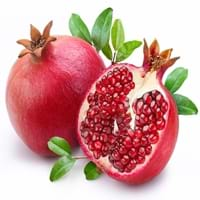Benefits
Health Benefits
Cancer prevention, Diarrhea treatment, Prevents constipation, Scurvy treatment, Treatment of dysentary
Cancer prevention, Heart care, Helps in cartilage regeneration, Improves stomach health, Increase in haemoglobin, Increases metabolic rate, Prevents constipation
General Benefits
Controls blood pressure, Cures cough, Improves eye vision, Maintains healthy cholesterol level, Treatment of common cold
Boosts immune system, Controls blood pressure, Controls blood sugar levels, Digestive aid, Maintains healthy cholesterol level
Skin Benefits
Anti-aging benefits, Brightens and lightens complexion, Hydrates skin, Treatment of skin diseases
Anti-aging benefits, Skin rejuvenation, Treatment of acne
Hair Benefits
Prevents hair loss
Prevents hair loss, Promotes longer and healthier hair, Treatment of dandruff
Allergy
Allergy Symptoms
Breathing difficulty, Coughing, Runny nose, Sneezing, Swelling of mouth, tongue or lips, Wheezing
Abdominal pains, Anaphylaxis, Itching
Side Effects
Hair thinning, Nail thinning, Skin problems, Tooth decay, Weakness, Possibly unsafe during pregnancy
Allergic reaction, Cold, Breathing difficulty, Irritation, Swelling
Recommeded for
Pregnant Women
Yes
Yes
Lactating Women
Yes
Yes
Best Time to Eat
As a snack in the late afternoon, Don't consume at night and before bed, Eat the fresh ones, avoid mixing with any other foods, don't eat after meal., Morning time (before lunch)
Best if taken as a breakfast (or empty stomach), As a snack in the late afternoon, Eat the fresh ones, avoid mixing with any other foods, don't eat after meal., Morning time (before lunch)
Nutrition
Serving Size
100 g
100 g
Carbs
14.30 g
30
18.70 g
14
Fiber
5.40 g
8
4.00 g
14
Sugar
8.90 g
30
13.67 g
10
Protein
2.50 g
5
1.67 g
13
Protein to Carb Ratio
0.18
9
0.09
16
Vitamins
Vitamin A (Retinol)
31.00 mcg
16
0.00 mcg
37
Vitamin B1 (Thiamin)
0.07 mg
13
0.07 mg
13
Vitamin B2 (Riboflavin)
0.04 mg
23
0.05 mg
19
Vitamin B3 (Niacin)
1.08 mg
7
0.29 mg
99+
Vitamin B5 (Pantothenic Acid)
0.45 mg
6
0.38 mg
9
Vitamin B6 (Pyridoxin)
0.11 mg
14
0.08 mg
22
Vitamin B9 (Folic acid)
49.00 mcg
3
38.00 mcg
5
Vitamin C (Ascorbic Acid)
228.30 mg
1
10.20 mg
99+
Vitamin E (Tocopherole)
0.73 mg
15
0.60 mg
16
Vitamin K (Phyllochinone)
2.60 mcg
24
16.40 mcg
5
Lycopene
5,204.00 mcg
1
0.00 mcg
9
Lutein+Zeaxanthin
0.00 mcg
36
0.00 mcg
36
Choline
7.60 mg
13
7.60 mg
13
Fat
0.95 g
7
1.17 g
5
Minerals
Potassium
417.00 mg
10
236.00 mg
29
Iron
0.26 mg
39
0.30 mg
35
Sodium
2.00 mg
18
3.00 mg
17
Calcium
18.00 mg
23
10.00 mg
34
Magnesium
22.00 mg
11
12.00 mg
23
Zinc
0.23 mg
12
0.35 mg
7
Phosphorus
40.00 mg
8
36.00 mg
13
Manganese
0.15 mg
21
0.12 mg
28
Copper
0.23 mg
5
0.16 mg
10
Selenium
0.60 mcg
10
0.50 mcg
11
Fatty Acids
Omega 3s
112.00 mg
6
0.00 mg
38
Omega 6s
288.00 mg
5
79.00 mg
25
Sterol
Water Content
80.80 g
99+
77.93 g
99+
Ash
1.40 g
5
0.53 g
23
Calories
Serving Size
100 g
100 g
Calories in Fresh Fruit with Peel
68.00 kcal
15
Not Available
Calories in Fresh Fruit without Peel
Not Available
83.00 kcal
8
Calories in Frozen Form
Not Available
Not Available
Calories in Dried Form
325.00 kcal
13
366.66 kcal
8
Calories in Canned Form
57.00 kcal
19
Not Available
Calories in Foods
Calories in Juice
55.00 kcal
25
60.00 kcal
22
Calories in Jam
240.00 kcal
21
210.00 kcal
25
Calories in Pie
340.00 kcal
11
360.00 kcal
9
Characteristics
Type
Tree fruit, Tropical
Tree fruit
Season
All seasons
Autumn
Varieties
Lucknow 49, Allahabad Safeda, Chittidar, Harijha, Apple guava, Hafshi, Arka Mridula and Allahabad Surkha
Balegal, Crab, Cloud, Francis, Freshman and Granada
Seedless Variety
No
No
Color
Green, Pink, Yellow
Dark red, Light pink-red
Inside Color
White
Red
Shape
Round
Round
Texture
Crispy
Juicy
Taste
Sweet-Sour
Juicy, Sweet
Origin
Central America, Mexico, South America
India, Iran
Grows on
Trees
Trees
Cultivation
Soil Type
Loam, Rocky, Sandy
Clay, Sand
Soil pH
4.5-7
5.5-7
Climatic Conditions
Sunny
Cold, Dry, Hot
Facts
Facts about
- The black pigment in Guava leaves is used for textile applications.
- Guava leaves are used to make tea.
- Oils extracted from guava seeds are used in various cosmetics.
- Guava wood is used for decorative purposes.
- Pomegranate means apple with many seeds.
- It was called as the “apple of Grenada” in early English.
- In Hinduism, this fruit symbolizes prosperity and fertility.
- Pomegranate trees can live upto 200 years.
In Alcoholic Beverages
Wine
Yes
Yes
Beer
Yes
Yes
Spirits
Yes
Yes
Cocktails
Yes
Yes
Production
Top Producer
India
Iran
Other Countries
China, Indonesia, Mexico, Nigeria, Pakistan, Philippines, Thailand
Africa, India, Middle east, Pakistan
Top Importer
Canada
Europe
Top Exporter
India
India
Scientific Name
Botanical Name
Psidium guajava
Punica granatum
Synonym
Not Available
Punica malus
Classification
Domain
Eukarya
Eukarya
Kingdom
Plantae
Plantae
Subkingdom
Tracheobionta
Tracheobionta
Division
Magnoliophyta
Magnoliophyta
Class
Magnoliopsida
Magnoliopsida
Subclass
Rosidae
Rosidae
Order
Myrtales
Myrtales
Family
Myrtaceae
Lythraceae
Genus
Psidium
Punica
Species
Psidium guajava
P. granatum
Generic Group
Myrtle
Pomegranate












